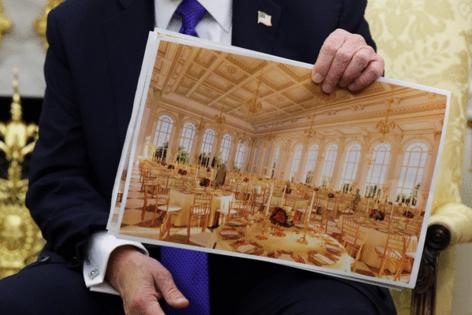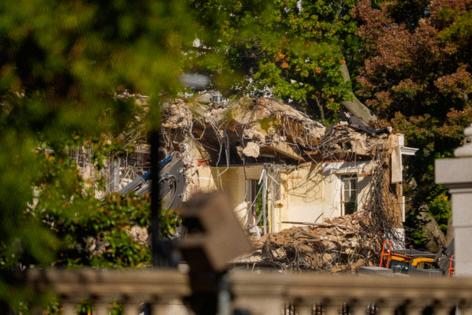East Wing demolition highlights loopholes in preservation law
Published in News & Features
WASHINGTON — The Trump administration’s decision to demolish the East Wing of the White House without consulting preservation agencies and organizations is a reflection in part of the unusual position the building has in historical preservation law.
And when it comes time to jump through bureaucratic hoops to construct the actual 90,000-square-foot ballroom, President Donald Trump has stacked the deck of the local planning commission in such a way as to make approval all but a foregone conclusion.
Sara Bronin, who chaired the Advisory Council on Historic Preservation during the Biden administration, said she’s looking at possible legal remedies, including who may have a cause of action.
“There’s a sense that protections on one of the country’s most important buildings should have been a lot stronger from the start,” Bronin added. “And as we look to what is going to happen next, including plans for construction, I do think we need to get a better understanding about every step that the White House didn’t take this time and must take next time.”
But it’s not clear that a Virginia couple who filed suit in federal court on Thursday to stop the project, or anyone else for that matter, will have legal grounds to make a difference.
Democrats and other opponents of the move have argued the administration should have gone through public review processes before demolition began. But the main historic preservation statute has an exemption for the entire building that, in an extreme and unlikely scenario, could theoretically allow an administration to raze the entire White House to the ground.
The 1966 law known as the National Historic Preservation Act specifically exempts three buildings from its provisions: the Supreme Court, the Capitol and the White House. Alterations to the White House, including the East Wing, aren’t subject to the requirement that federal agencies identify the effect of changes on historic buildings.
“We could see the whole White House come down if the Trump administration decides to use the same arguments that they just used to demolish the East Wing,” Bronin said.
White House press secretary Karoline Leavitt said on Thursday the administration wasn’t required to submit plans for demolition. She said the administration would be required to submit a plan before construction begins on the ballroom itself.
A 1952 federal law requires the administration to submit any new construction plans to a local planning board known as the National Capital Planning Commission.
But that 12-member agency is headed by the White House staff secretary, Will Scharf, and most of the other commission members are Trump administration loyalists as well. They include the secretaries of Interior and Defense, the head of the General Services Administration and the chairs of congressional committees with oversight of the District of Columbia.
The president also appoints the head of the National Park Service, the agency that manages White House construction projects. The president also names members of the Commission of Fine Arts, which is supposed to be consulted on such projects.
Administration officials say the demolition of the East Wing to make space for a larger addition of a ballroom is the latest in a series of renovation and modernization projects done by other presidents.
The decisions to date, however, contrast with those made by previous administrations — including the first Trump administration when it submitted plans to build a tennis pavilion to bodies that have an interest in the grounds, including the National Capital Planning Commission and the Commission of Fine Arts. The project went through, and construction wrapped up in late 2020.
Even Congress, which appropriates funding for the executive branch, has been sidelined thanks to the White House’s reliance on private donors, who’ve contributed roughly $350 million for the project, according to Trump.
Contributors include Google LLC, Blackstone Inc., OpenAI, Coinbase Global Inc., Palantir Technologies Inc. and Lockheed Martin Corp., among others, with donations being handled through the Trust for the National Mall, a nonprofit.
Still, Democrats and others with a stake in the matter are demanding answers.
House Natural Resources ranking member Jared Huffman, D-Calif., Oversight and Government Reform ranking member Robert Garcia, D-Calif., and Rep. Yassamin Ansari, D-Ariz., sent a letter to Trump on Thursday requesting documentation on the demolition and plans for the ballroom.
“This project represents one of the most substantial alterations to the White House in modern history. The decisions were made in complete secrecy and undertaken without public disclosure or proper consultation,” the letter said.
In a separate letter Thursday, House Financial Services Appropriations Subcommittee ranking member Steny H. Hoyer, D-Md., and three other Democrats on the panel raised concerns that “the White House is proceeding without the requisite, legally required public review processes, including consultation and review by the National Capital Planning Commission and the Commission of Fine Arts.”
The letter — sent to to Scharf, Office of Management and Budget Director Russ Vought and acting National Park Service Director Jessica Bowron — said the donations for the ballroom represent “conflicts of interest, including expectations of pay for play, for entities regulated by the administration.”
“All presidents, including President Trump, are tenants by virtue of the votes of the American people,” the letter said. “Changes to the People’s House should thus be transparent, publicly funded, and done with the consent of the Congress.”
They asked for answers to a series of questions about the project by Oct. 29, but there’s no guarantee of a response.
The National Trust for Historic Preservation, a congressionally chartered nonprofit, sent a letter Tuesday to the Park Service, NCPC and the CFA requesting the administration pause demolition until the proposed ballroom goes through the public review process.
“These processes provide a crucial opportunity for transparency and broad engagement — values that have guided preservation of the White House under every administration going back to the public competition in 1792 that produced the building’s original design,” CEO Carol Quillen wrote.
The trust said that the massive ballroom “may also permanently disrupt the carefully balanced classical design of the White House with its two smaller, and lower, East and West Wings.”
The demolition of the East Wing and construction of the ballroom is the latest Trump step to leave his mark on Washington, including the construction of a patio in the Rose Garden. He has also floated the possibility of a memorial arch in front of Arlington National Cemetery.
©2025 CQ-Roll Call, Inc., All Rights Reserved. Visit cqrollcall.com. Distributed by Tribune Content Agency, LLC.










Comments